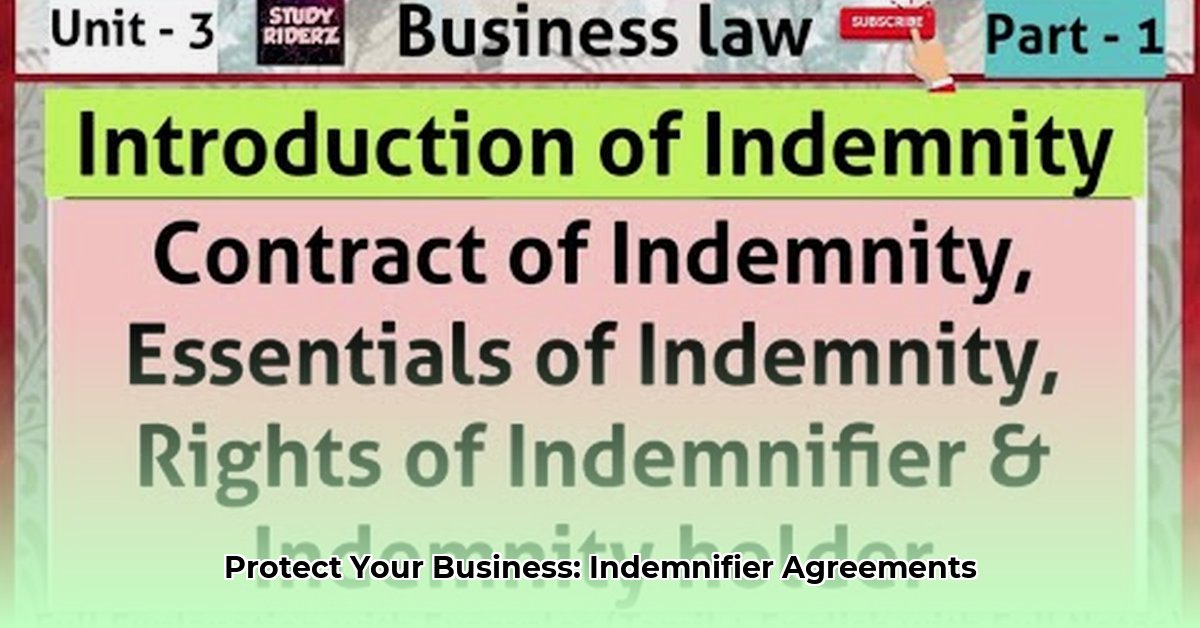
Protecting your business from unexpected financial setbacks is paramount. Indemnification agreements act as a crucial financial safety net, shifting the risk of specific losses from your company to another party. This guide provides actionable steps to understand and utilize these agreements effectively.
Understanding Indemnification: Your Financial Shield
An indemnification agreement is a contract where one party (the indemnifier) agrees to compensate another (the indemnitee) for specified losses or damages. Think of it as a contractual insurance policy. It's a critical tool in various business scenarios, from simple contracts to complex mergers. A robust indemnification agreement can significantly reduce your financial exposure.
Why You Need an Indemnification Agreement: Protecting Your Bottom Line
Imagine launching a successful product only to face massive lawsuits due to an unforeseen manufacturing defect. The costs of legal fees and compensation claims could cripple your business. A well-structured indemnification agreement could have significantly mitigated this risk. It is not a luxury but a fundamental aspect of responsible risk management.
Crafting Bulletproof Indemnifier Clauses: A Step-by-Step Guide
Creating effective indemnification clauses requires precision and clarity. Vague language can lead to costly disputes, leaving you unprotected. Follow these steps to build robust protection:
Define the Scope: Explicitly state what losses are covered. Use precise language, avoiding vague terms like "significant damages". Instead, provide specific monetary limits or clearly define the types of damages covered (e.g., property damage, personal injury, lost profits). High specificity is crucial.
Identify the Parties: Clearly name both the indemnifier and the indemnitee, including their full legal names and addresses. Absolutely no ambiguity should exist.
Pinpoint Triggering Events: Specify the exact circumstances that trigger the indemnifier's obligation. For example, clearly define if the indemnifier is responsible for damages related to product malfunction, patent infringement, or breach of contract. The clearer this is, the better.
Set Clear Limits and Exclusions: Establish reasonable limits on liability to avoid excessive exposure. Define situations or damages explicitly excluded from the agreement. This prevents future misunderstandings.
Outline the Claims Process: Detail how claims are processed. Specify the method of claim submission (e.g., written notice, specific form required), response timeframes, and a clear dispute resolution process (mediation or arbitration). Clarity in this process streamlines resolution.
Assessing Your Risks: Identifying Potential Weak Points
Before crafting an indemnification agreement, assess your potential liabilities. What situations could inflict significant financial harm? A thorough risk assessment is crucial.
Here’s a risk assessment matrix to guide your analysis:
| Risk Factor | Likelihood | Impact (Severity) | Mitigation Strategy |
|---|---|---|---|
| Weak Contract Language | Very Likely | Very High | Thorough legal review; precise, unambiguous wording |
| Unexpected Events | Possible | High | Comprehensive insurance; detailed contingency planning |
| Regulatory Changes | Possible | Medium | Continuous monitoring of regulations; expert legal counsel |
| Failure to Enforce the Agreement | Unlikely | Very High | Prompt, decisive action; documented breaches; legal action |
Who Needs Indemnification? The Short Answer: Everyone.
Businesses of all sizes face potential risks. Indemnification is not about avoiding risk entirely, rather, it’s about managing the financial impact of unforeseen events. It's a proactive strategy protecting your business's future.
The Importance of Legal Expertise: Seeking Professional Guidance
Crafting a truly protective indemnification agreement requires expert legal advice. Attempting to handle this complex process alone is highly risky. A qualified attorney ensures your agreement is legally sound and protects your interests. This legal investment is a small price to pay compared to the potential costs of poorly drafted agreements.
How to Craft Legally Sound Indemnification Clauses in Business Contracts
Successfully implementing indemnification requires a robust understanding of your risks. The indemnification clause is a cornerstone of any commercial contract, but drafting it effectively demands precision.
Understanding the Basics: What is Indemnification?
Indemnification, in essence, is a promise to compensate another party for incurred losses or damages. It acts as a crucial risk-allocation mechanism within contracts, protecting your business from unforeseen consequences. A well-structured clause prevents future disputes.
Key Elements of a Strong Indemnification Clause:
Clearly Defined Scope: Specify the exact events triggering indemnification (negligence, willful misconduct, etc.). Avoid ambiguous terminology.
Specific Covered Losses: List all covered damages (direct losses, consequential damages, legal fees). Detailed specification is paramount.
Triggering Events: Clearly define specific situations activating indemnification. Precise examples enhance clarity.
Limitations of Liability: Include reasonable monetary limits to control exposure. Caps or exclusions are often used for risk management.
Insurance: Require the indemnifying party to maintain adequate insurance. This ensures they can meet their obligations.
Governing Law: Specify the relevant jurisdiction for dispute resolution, providing a clear legal framework.
Drafting Your Indemnification Clause: A Practical Guide
Legal Counsel: Always consult with an experienced contract attorney to ensure compliance and protect your interests.
Collaboration: Discuss the clause thoroughly with the other party to foster mutual understanding and reduce potential disputes.
Plain Language: Use clear, concise language that avoids ambiguous legal jargon. Clarity avoids future issues.
Review and Revise: Carefully review the final clause before signing the contract. Thorough review is crucial.
Example Scenarios: Illustrating the Importance of Clarity
Scenario 1: Joint Venture: A clear breakdown of liability is vital in joint ventures, preventing disputes over each partner’s actions.
Scenario 2: Product Liability: If a product causes harm, a well-defined indemnification clause determines responsibility, preventing costly litigation.
Comparing Indemnification Clause Structures: Mutual vs. Unilateral
Indemnification agreements can be mutual (both parties indemnify each other) or unilateral (one party indemnifies the other). The optimal approach depends on the specific risk assessment and context. Mutual agreements offer balanced protection, while unilateral agreements may be necessary when one party faces significantly higher risk.
Key Takeaways:
Crafting legally sound indemnification clauses requires precision, legal expertise, and a thorough understanding of potential risks. Prioritize specificity, clarity, and professional guidance to ensure robust protection for your business.